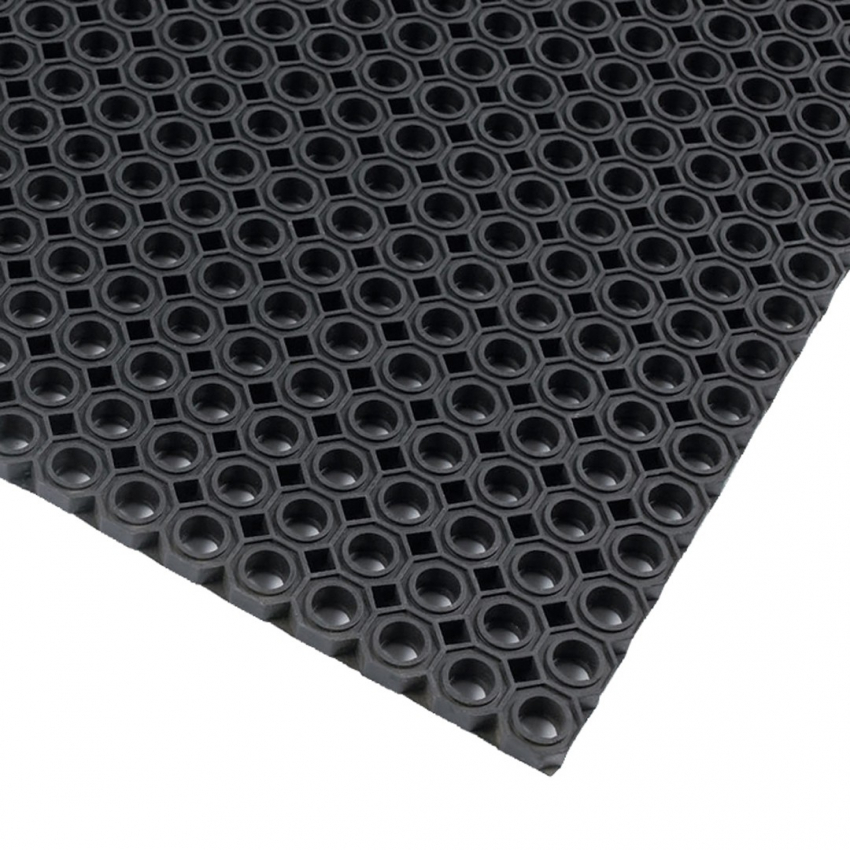










This matting system allows a smooth transition of your entrance mats from outside to inside. Based on a unique design, this rubber mat scrapes off shoes to prevent dirt from entering buildings. Specially designed to facilitate the passage of people with reduced mobility, canes or stiletto heels, in compliance with accessibility standards. Its smooth surface allows access to wheels (carts, suitcases, etc.).
What makes this system of connectable tiles revolutionary is the ability to effortlessly create sturdy, uniform customized surfaces without glue.
Available in standard and custom sizes.
The 50 cm x 50 cm tiles can cover fairly large areas, and can be assembled on site for installation between mat frames in large entrances. Made from robust natural rubber, this product is hard-wearing, slip-resistant and designed for the heaviest traffic areas.This system offers all the advantages of modular mats that are easy to install, adjust or move.
Can be fully customized with a wide selection of mat inserts in a variety of colors. Available in nitrile for oil and fire resistance Bfl/S1.
RECOMMENDED APPLICATIONS :
For indoor and outdoor pits.

| Master Flex D12 |
Data sheet
| Format | Slabs |
| Surface | Gratings Openwork |
| Design | Octagonal cells Octagonal cells |
| Location | Exterior Interior Outdoor under cover |
| Intensity of passage | Very intense |
| Properties | Draining Non-slip Scraping |
| Composition | Natural rubber |
| Thickness | 12 mm |
| Weight | 2,4kg/slab |
| Borders | Connectable bevelled edges available |
| Resistant to chemicals | No |
| Maintenance / Cleaning | High pressure water jet |
| Operating temperature | Suitable for use in extreme weather conditions |
Anti-dirt-repellent mats are the first line of defense in keeping dirt and debris out of buildings. They improve air quality, reduce noise resonance, extend floor life and cut maintenance costs.
Dirt-repellent mats also facilitate access for people with reduced mobility, while ensuring the safety of all users (avoiding falls, slips, etc.). But they also contribute to the cleanliness and hygiene of your premises, while enhancing your image, since the entrance is the first impression your customers will have of your establishment.
To cut a long story short, a dirt-repellent mat must meet 3 main criteria:
When choosing an antisoiling mat, there are a few criteria to consider:
Your environment:
Type of traffic :
There are 3 ranges of dirt-repellent mats:
Professional dirt-repellent mats are used in all establishments with one or more entrances, such as :
We offer a wide choice of dirt-repellent mats:
Custom mats meet a number of objectives, not only for cleanliness but also for communication. They are innovative communication tools that will make you stand out from your competitors and standardize your franchises.
They can be used to welcome your customers in your image, give you visibility from the outside and attract passers-by who don't yet know you. They can also be used as a gift from you to your partners, or as a point-of-sale advertising tool.
You can use personalized mats for :
To choose a customized mat, you first need to know your needs:
Then choose where to place it: indoors or outdoors.
Customized mats help you stand out from your competitors, make your entrance look as good as your brand image, attract passers-by if the mat is outdoors, advertise in an innovative way.
We offer you a range of customized mats with different functionalities and a wide choice of colors.
We can offer you visuals, provided you give us your personalization requirements: logo, company name, details of services offered, etc., and we'll send you a mock-up.
Grating is a square slab of metal, polyester, rubber or PVC, made up of several parallel slats. The slats come in a variety of sizes, species and colors, and are grooved to prevent water from stagnating and the floor from becoming slippery.
Polyester gratings: Food industry - Paper and cellulose industry - Pharmaceutical industry - Plastics industry - Fiber and textile industry - Automotive and aircraft construction - Offshore installation - Sewage treatment plant - Navy and shipbuilding - Transport - Pickling and galvanizing plant.
Rubber gratings: Can be used in a wide range of applications: building entrances, walkways, stairs, access paths, production lines, ski resorts, etc.
Hygienic gratings: swimming pools - changing rooms - saunas - hotels - kitchens - steam rooms, etc.
Metal gratings: Thermal, hydroelectric, nuclear and solar power plants - Chemical and oil industries - Automotive and steel industries - Shipbuilding - Cement works - Metal processing and construction - Railways and transport
Test one outdoor anti-slip mat